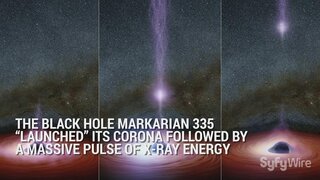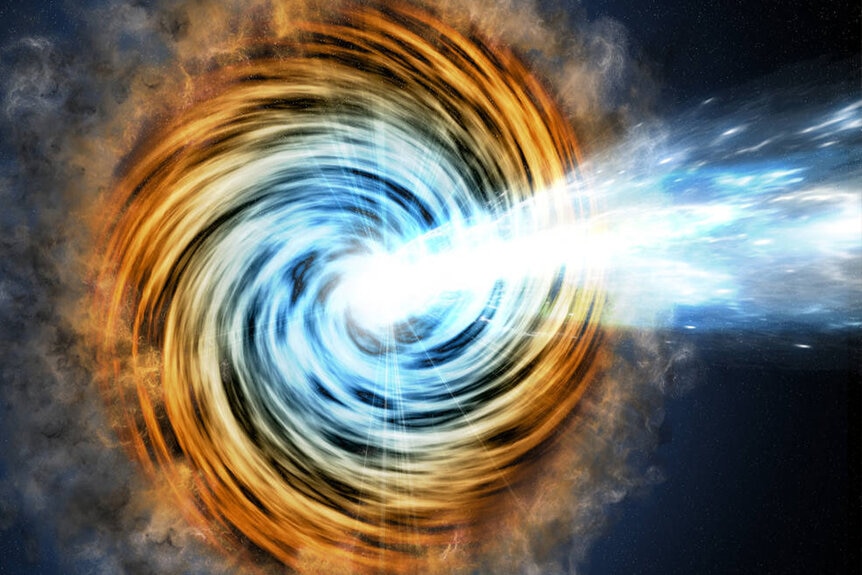Create a free profile to get unlimited access to exclusive videos, sweepstakes, and more!
A supermassive black hole just turned toward Earth, firing its charged beam our way
You've changed, black hole. You used to be different.

In Despicable Me (now streaming on Peacock!), Gru (Steve Carrell) gets into a contest of oneupmanship with his nemesis, Vector (Jason Segal), which escalates to the point of shrinking and stealing the Moon. Now, there’s a death ray pointing at our planet, sort of, that Gru and Vector didn’t have anything to do with it, nor any supervillain for that matter. Astronomers recently observed a black hole in the heart of a distant galaxy which turned its gaze (a charged beam of particles) directly toward us. Fortunately, we’re not in any danger, but it did force a shakeup in the classification of the black hole and the galaxy around it.
Astronomy, like all sciences, is additive in nature. We learn more information and we discard or amend old ideas to fit the evidence. Sometimes, that means we change our definitions or classifications of things. One species becomes two, a planet becomes a dwarf planet, and a radio galaxy… gets larger and becomes something else?
RELATED: The face of Pluto is slowly changing and now we know why
That’s seemingly what happened, according to a recent paper published in the Monthly Notices of the Royal Astronomical Society. An international team of astronomers was investigating the galaxy PBC J2333.9-2343 (it’s not a glamorous name, we’re going to call it Peanut butter & celery), located roughly 650 million light years away, when they realized it had experienced a growth spurt since the last time they had seen it. Previously, the distant galaxy had been classified as a radio galaxy, thanks to regions of radio emissions extending well beyond the visible structure of the galaxy. The recent observations, however, revealed a different sort of galaxy entirely, forcing a reclassification to GIANT radio galaxy.
We saw something like this with the reclassification of Pluto. Objects in space get renamed, redescribed, re-explained, and reclassified all the time. That’s how science works. When new information arises, we adjust our models and edge ever nearer to the truth. Or at least a version of it. Pluto was unique in this regard because so many people had become emotionally attached to the small, icy planetoid, to a degree that probably surprised even them. It happens. Some of us fall in love with space rocks and some of us (Gru) accidentally adopt three kids while we’re trying to take over the world. What are you gonna do?
Researchers gathered light from Peanut butter & celery in every part of the spectrum they could. Using telescopes at the German 100m-Radio Telescope Effelsberg at the Max Planck Institute for Radio Astronomy, the Yale University 1.3m-SMARTS optical telescope, and the Penn State Neil Gehrels Swift Observatory, they pointed optical, radio, infrared, x-ray, UV, and gamma ray instruments at the galaxy to get as much data as possible.
Those observations confirmed that the orientation of the black hole had changed up to 90 degrees. Previously, it was pointing into the plane of the sky, perpendicular to us, and now it is shining like a spotlight pointed directly at Earth. They also saw that previous radio lobes were no longer being fed by the black hole, but were still-glowing regions leftover from past activity. That is consistent with a change in jet direction. The bigger tell is that Peanut butter & celery is super bright, when compared with other radio galaxies, like staring into a galactic headlight. That, too, is a result of the black hole’s beam.
As a result, the black hole itself received a new designation: blazar. Those are a subgroup of black holes in the center of a galaxy, known as an active galactic nucleus (AGN), with a relativistic jet pointed directly at the observer. There’s nothing fundamentally different between blazars and other AGNs, except that we can see them better because they are pointing our way.
RELATED: Unidentified blazar-like objects are blasting out gamma rays, and it gets weirder
Ultimately, it’s the direction of the jet that changed the classification of the galaxy, as well. Because the beam is pointed our way, radio emissions are strongly enhanced from our point of view. The intensity of radio flares is stronger. Strong enough to overwhelm emissions from the rest of the galaxy and outshine every other radio galaxy in view.
The classification change, both of the black hole and the galaxy (not to mention poor old Pluto) has little to do with a change (either real or in our understanding) of the object itself, but it has a whole lot more to do with our point of view. It’s a window into how we understand the universe from our unique perspective in the cosmos. Classifications can tell us useful information about the objects they categorize, but they also tell us something about ourselves.
It's hard not to get a little introspective when you are quite literally staring into the abyss, and the abyss is staring back.
Try to forget about it for a little while; watch Despicable Me on Peacock, instead. If you’re still feeling existentially wiggly, chase it down with Despicable Me 2.



























